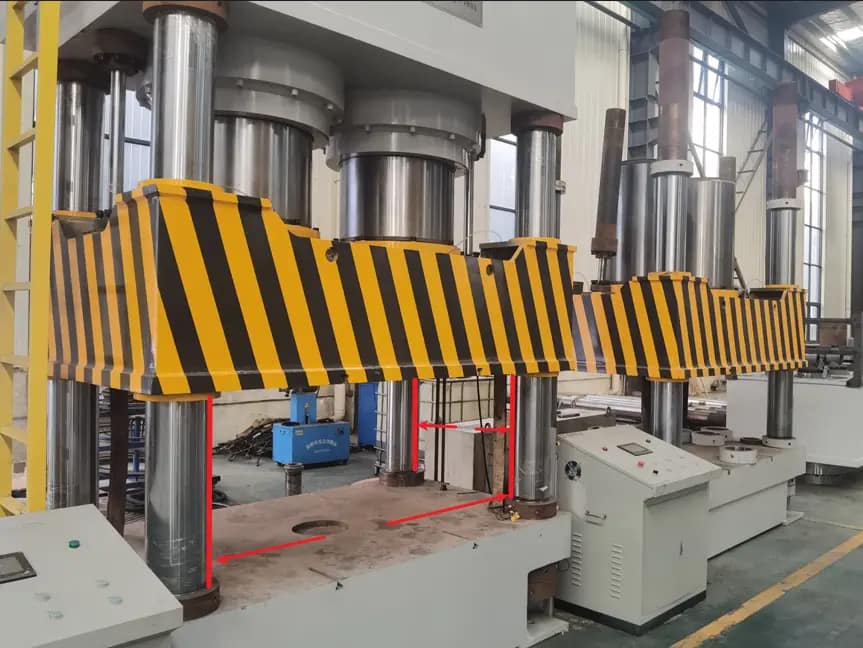Selecting the appropriate molded pallet press is critical for ensuring efficient production, high-quality pallets, and long-term equipment reliability. Before purchasing a press, it’s essential to define the pallet specifications based on customer requirements. Common molded pallet sizes include 600x800mm, 1100x1100mm, 1200x1200mm, 1200x1000mm, 1200x800mm, and 1140x1140mm. To choose the right press, two key factors must be considered: the worktable size and the press’s working pressure. This article outlines these factors and guides in calculating the required working pressure to produce durable, high-quality molded pallets.
1. Worktable Size: Accommodating the Mold
The worktable size of a press refers to the distance between the inner sides of the press’s four columns. This space must be sufficient to accommodate the mold, allowing it to be securely placed and fixed. The worktable size determines the maximum pallet dimensions the press can produce.

For example, if a customer requires pallets with a maximum size of 1200x1200mm, the press’s worktable must be large enough to house a mold of this size. A press capable of producing 1200x1200mm pallets is versatile, as it can also accommodate smaller pallet molds, such as 1200x1000mm, 1100x1100mm, 1200x800mm, or 600x800mm). Selecting a press with a worktable size ensures flexibility to produce multiple pallet sizes, enabling manufacturers to meet diverse customer needs with a single machine.
2. Press Working Pressure: Ensuring Pallet Quality
The performance of a molded pallet press is also defined by its pressure capacity, which includes design pressure and working pressure.
- Design pressure is the maximum pressure the press is engineered to handle safely.
- Working pressure is the actual pressure applied during pallet production, which is always lower than the design pressure.
The working pressure must be tailored to the pallet’s surface area to achieve the desired density and strength. Insufficient pressure can result in low-density pallets that are weak, prone to damage, and less durable. Additionally, inadequate pressure may cause forming issues, increasing the defect rate, and production costs.
👉Posts about presswood pallet density and pallet molding machine pressure
1. Presswood Pallet Load Capacity Guide
2. How to prevent termites in presswood pallets
3. Pressure Affects the Quality of Molded Pallets
Calculating the Required Working Pressure
Based on industry standards, molded pallets typically require approximately 1,000 tons of working pressure per square meter of pallet surface area. This rule of thumb allows manufacturers to calculate the necessary working pressure based on the pallet’s dimensions.
For example, consider a pallet with dimensions of 1140x1140mm:
- Convert dimensions to meters: 1140mm = 1.14m, 1140mm = 1.14m.
- Calculate surface area: 1.14m × 1.14m = 1.2996 m².
- Determine working pressure: 1.2996 m² × 1,000 tons/m² ≈ 1299.6 tons.
Therefore, a press producing a 1140x1140mm pallet requires a working pressure of approximately 1300 tons. To ensure safe and reliable operation, the press’s design pressure should have a capacity of at least 1500–1600 tons, providing a safety margin to handle the working load.
Why Choosing the Right Press Matters
Selecting the appropriate molded pallet press is not only about producing pallets of varying sizes but also about ensuring consistent quality and maximizing the press’s service life. A well-matched press enhances production efficiency, reduces defect rates, and delivers pallets that meet stringent industry standards. Key benefits include:
- Versatility: A press with a sufficiently large worktable can produce multiple pallet sizes, reducing the need for dedicated machines for each size.
- Quality: Adequate working pressure ensures pallets are dense, strong, and durable, meeting customer expectations.
- Longevity: Operating a press within its design pressure capacity minimizes wear and tear, extending equipment lifespan.
Conclusion
Investing in the right molded pallet press requires careful consideration of the worktable size and working pressure to align with your production goals. By calculating the required working pressure (approximately 1,000 tons per square meter) and ensuring the worktable can accommodate the largest mold size, manufacturers can select a press that offers flexibility, reliability, and high-quality output. A well-chosen press not only optimizes production but also enhances pallet durability and extends the machine’s operational life, delivering long-term value to your business.
👉 Related: What Materials Can Be Used to Make Molded Pallets?
👉 Related: Different pressure presswood pallet machine


